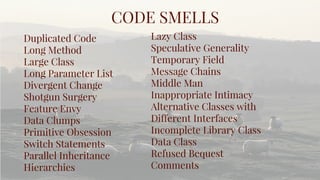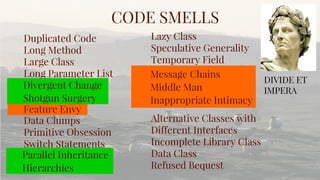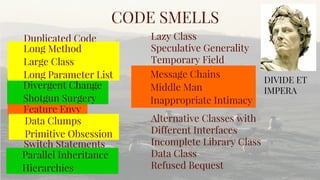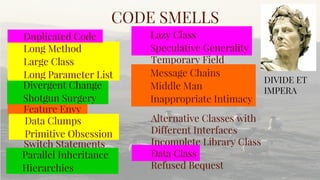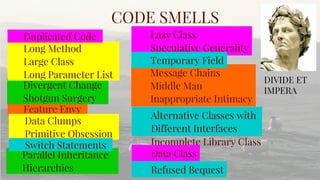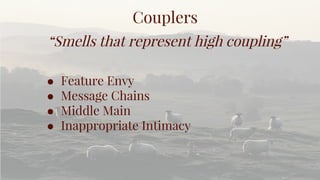Code Smells: Farejando o c├│digo
- 2. Code Smells: Farejando o c├│digo Jo├Żo Pontes UNIC
- 4. ŌĆ£We have looked at lots of code, written for projects that span the gamut from wildly successful to nearly dead. In doing so, we have learned to look for certain structures in the code that suggestŌĆösometimes, scream forŌĆöthe possibility of refactoring.ŌĆØ (Martin Fowler, Kent Beck) ŌĆ£Are warning signs about potential problems in code. Not all smells indicate a problem, but most are worthy of a look and a decision.ŌĆØ (William C. Wake) DEFINI├ć├āO
- 5. LITERATURA 2000 - ŌĆ£The Pragmatic Programmer: From Journeyman to MasterŌĆØ ŌĆ£Rather than construction, software is more like gardeningŌĆöit is more organic than concrete. You plant many things in a garden according to an initial plan and conditions. Some thrive, others are destined to end up as compost. [ŌĆ”] You constantly monitor the health of the garden, and make adjustments (to the soil, the plants, the layout) as needed.ŌĆØ
- 6. LITERATURA 2000 - ŌĆ£Refactoring: Improving the Design of Existing CodeŌĆØ 2003 - ŌĆ£Refactoring WorkbookŌĆØ 2005 - ŌĆ£Refactoring to PatternsŌĆØ
- 7. LITERATURA 2006 - ŌĆ£A Subjective Evaluation of Software Evolvability Using Code Smells: An Empirical StudyŌĆØ 2018 - ŌĆ£Refactoring: Improving the Design of Existing Code 2nd Edition)ŌĆØ
- 8. Duplicated Code Long Method Large Class Long Parameter List Divergent Change Shotgun Surgery Feature Envy Data Clumps Primitive Obsession Switch Statements Parallel Inheritance Hierarchies CODE SMELLS Lazy Class Speculative Generality Temporary Field Message Chains Middle Man Inappropriate Intimacy Alternative Classes with Different Interfaces Incomplete Library Class Data Class Refused Bequest Comments
- 9. Duplicated Code Long Method Large Class Long Parameter List Divergent Change Shotgun Surgery Feature Envy Data Clumps Primitive Obsession Switch Statements Parallel Inheritance Hierarchies CODE SMELLS Lazy Class Speculative Generality Temporary Field Message Chains Middle Man Inappropriate Intimacy Alternative Classes with Different Interfaces Incomplete Library Class Data Class Refused Bequest DIVIDE ET IMPERA
- 10. Duplicated Code Long Method Large Class Long Parameter List Divergent Change Shotgun Surgery Data Clumps Primitive Obsession Switch Statements Parallel Inheritance Hierarchies CODE SMELLS Lazy Class Speculative Generality Temporary Field Alternative Classes with Different Interfaces Incomplete Library Class Data Class Refused Bequest DIVIDE ET IMPERA Feature Envy Message Chains Middle Man Inappropriate Intimacy
- 11. Duplicated Code Long Method Large Class Long Parameter List Data Clumps Primitive Obsession Switch Statements CODE SMELLS Lazy Class Speculative Generality Temporary Field Alternative Classes with Different Interfaces Incomplete Library Class Data Class Refused Bequest DIVIDE ET IMPERA Feature Envy Message Chains Middle Man Inappropriate Intimacy Divergent Change Shotgun Surgery Parallel Inheritance Hierarchies
- 12. Duplicated Code Switch Statements CODE SMELLS Lazy Class Speculative Generality Temporary Field Alternative Classes with Different Interfaces Incomplete Library Class Data Class Refused Bequest DIVIDE ET IMPERA Feature Envy Message Chains Middle Man Inappropriate Intimacy Divergent Change Shotgun Surgery Parallel Inheritance Hierarchies Long Method Large Class Long Parameter List Data Clumps Primitive Obsession
- 13. Switch Statements CODE SMELLS Temporary Field Alternative Classes with Different Interfaces Incomplete Library Class Refused Bequest DIVIDE ET IMPERA Feature Envy Message Chains Middle Man Inappropriate Intimacy Divergent Change Shotgun Surgery Parallel Inheritance Hierarchies Long Method Large Class Long Parameter List Data Clumps Primitive Obsession Duplicated Code Lazy Class Speculative Generality Data Class
- 14. CODE SMELLS Incomplete Library Class DIVIDE ET IMPERA Feature Envy Message Chains Middle Man Inappropriate Intimacy Divergent Change Shotgun Surgery Parallel Inheritance Hierarchies Long Method Large Class Long Parameter List Data Clumps Primitive Obsession Duplicated Code Lazy Class Speculative Generality Data Class Switch Statements Temporary Field Alternative Classes with Different Interfaces Refused Bequest
- 15. Couplers ŌĆ£Smells that represent high couplingŌĆØ ŌŚÅ Feature Envy ŌŚÅ Message Chains ŌŚÅ Middle Main ŌŚÅ Inappropriate Intimacy
- 16. Change Preventers ŌĆ£Violate the rule which says that classes and possible changes should have a one-to-one relationshipŌĆØ ŌŚÅ Divergent Change ŌŚÅ Shotgun Surgery ŌŚÅ Parallel Inheritance Hierarchies
- 17. Bloaters ŌĆ£Something that has grown so large that it cannot be effectively handledŌĆØ ŌŚÅ Data Clumps ŌŚÅ Primitive Obsession ŌŚÅ Long Method ŌŚÅ Large Class ŌŚÅ Long Parameters List
- 18. Dispensables ŌĆ£They all represent something unnecessary that should be removed from the source codeŌĆØ ŌŚÅ Duplicated Code ŌŚÅ Lazy Class ŌŚÅ Speculative Generality ŌŚÅ Data Class ŌŚÅ Comments
- 19. Abusers ŌĆ£Cases where the solution does not fully exploit the possibilities of OOPŌĆØ ŌŚÅ Switch Statements ŌŚÅ Temporary Field ŌŚÅ Alternative Classes with Different Interfaces ŌŚÅ Refused Bequest
- 20. Conclus├Żo ŌĆ£The gardening metaphor is much closer to the realities of software development. Perhaps a certain routine has grown too large, or is trying to accomplish too muchŌĆöit needs to be split into two. Things that don't work out as planned need to be weeded or pruned.ŌĆØ To be continuedŌĆ” ŌĆ” Refactoring Techniques





![LITERATURA
2000 - ŌĆ£The Pragmatic Programmer:
From Journeyman to MasterŌĆØ
ŌĆ£Rather than construction, software is more like
gardeningŌĆöit is more organic than concrete.
You plant many things in a garden according to
an initial plan and conditions. Some thrive,
others are destined to end up as compost. [ŌĆ”]
You constantly monitor the health of the garden,
and make adjustments (to the soil, the plants, the
layout) as needed.ŌĆØ](https://image.slidesharecdn.com/codesmellsodp-190703210420/85/Code-Smells-Farejando-o-codigo-5-320.jpg)


